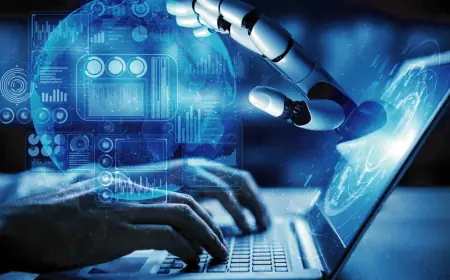Beyond Hard Hats The Future of Workplace Safety Innovations
Explore the future of workplace safety with AI, IoT, and VR. Learn how safety officer courses equip professionals with modern risk prevention skills.

Table of Contents
-
Introduction
-
The Evolution of Workplace Safety
-
The Role of Safety Officer Courses in Modern Safety Training
-
Emerging Technologies in Workplace Safety
-
4.1 Artificial Intelligence and Machine Learning
-
4.2 Virtual and Augmented Reality
-
4.3 Wearable Safety Devices
-
4.4 IoT and Smart Sensors
-
The Impact of Robotics and Automation
-
Digital Training and E-learning in Safety Courses
-
Advanced Personal Protective Equipment (PPE)
-
The Role of Data Analytics in Predicting Workplace Hazards
-
Sustainability and Eco-friendly Safety Innovations
-
Psychological Safety and Mental Well-being at Work
-
The Future of Safety Officer Courses
-
Conclusion
1. Introduction
Workplace safety has always been a priority for businesses worldwide. Over the years, the traditional approach to safety has revolved around protective gear like hard hats, gloves, and steel-toed boots. However, with technological advancements, the concept of workplace safety is undergoing a major transformation. Companies are now embracing innovative solutions that go beyond just physical protection, focusing on predictive and preventive measures to minimize risks.
One of the most significant drivers of this transformation is the emergence of safety officer courses that equip professionals with the necessary skills to implement modern safety protocols. These courses train individuals to use technology-driven solutions that enhance workplace safety and reduce accident rates.
2. The Evolution of Workplace Safety
From basic protective gear to automated safety solutions, workplace safety has evolved significantly. Decades ago, employers focused on reactive approaches, implementing measures only after accidents occurred. Today, proactive strategies are prioritized, emphasizing hazard prevention, risk assessment, and advanced safety training programs.
Modern safety training methods, including safety officer courses, are designed to keep pace with new risks emerging in diverse industries. As industries evolve, so do workplace hazards, necessitating advanced training programs that integrate the latest technological innovations to ensure maximum safety.
3. The Role of Safety Officer Courses in Modern Safety Training
Safety training is an essential aspect of workplace safety. Professionals who undergo safety officer courses acquire specialized knowledge about occupational safety laws, hazard identification, and emergency response procedures.
These courses cover topics such as:
-
Risk assessment and mitigation
-
Compliance with safety regulations
-
Emergency response and first aid training
-
Use of modern safety technology
-
Workplace ergonomics and injury prevention
Employers increasingly prefer hiring individuals with certified training, as they bring valuable insights into maintaining a safe work environment.
4. Emerging Technologies in Workplace Safety
With advancements in technology, workplace safety is no longer limited to traditional protective equipment. Here are some of the most impactful innovations reshaping workplace safety:
4.1 Artificial Intelligence and Machine Learning
AI-powered solutions are transforming workplace safety by analyzing real-time data to predict hazards. AI systems can identify patterns in workplace accidents and suggest preventive measures.
4.2 Virtual and Augmented Reality
VR and AR are revolutionizing safety training by providing immersive experiences that simulate hazardous situations. Trainees can practice handling emergencies in a risk-free environment, improving their response to real-world scenarios.
4.3 Wearable Safety Devices
Smart helmets, biometric wristbands, and exoskeletons are some examples of wearable technology that monitor workers’ health and prevent injuries. These devices track heart rate, temperature, and fatigue levels, alerting supervisors in case of anomalies.
4.4 IoT and Smart Sensors
IoT-enabled sensors detect hazardous conditions, such as gas leaks, fire risks, or equipment malfunctions. These sensors send instant alerts, allowing quick intervention before accidents occur.
5. The Impact of Robotics and Automation
Automation has significantly reduced workplace injuries by replacing humans in high-risk environments. Robots are now used for tasks such as heavy lifting, handling hazardous materials, and working in extreme temperatures.
6. Digital Training and E-learning in Safety Courses
Online safety courses have made safety training more accessible. These courses allow employees to learn at their own pace, ensuring better retention of safety protocols.
7. Advanced Personal Protective Equipment (PPE)
Modern PPE is designed with smart technology, integrating features such as real-time health monitoring, enhanced durability, and improved comfort for workers.
8. The Role of Data Analytics in Predicting Workplace Hazards
Data-driven safety programs analyze historical accident data to identify trends and potential risks. Predictive analytics enables companies to take preventive measures before accidents happen.
9. Sustainability and Eco-friendly Safety Innovations
Companies are adopting eco-friendly Safety Courses measures, such as biodegradable protective gear and energy-efficient safety solutions, to promote sustainability without compromising worker protection.
10. Psychological Safety and Mental Well-being at Work
A safe workplace goes beyond physical protection. Employers are focusing on mental health programs to reduce workplace stress and anxiety, ensuring holistic safety for employees.
11. The Future of Safety Officer Courses
As workplace safety evolves, so do safety officer courses. Future training programs will include AI-driven safety management, cybersecurity for industrial safety, and advanced risk assessment strategies. By integrating modern technology into these courses, safety professionals will be better prepared to handle new-age workplace risks.
Conclusion
The future of workplace safety is beyond hard hats and traditional safety measures. With emerging technologies like AI, IoT, and VR, workplace safety is becoming more proactive and efficient. Organizations that invest in safety officer courses and modern training programs ensure that their employees are well-equipped to handle potential hazards.
As industries continue to evolve, workplace safety innovations will remain a top priority, shaping a safer and more productive work environment for all.
What's Your Reaction?
 Like
0
Like
0
 Dislike
0
Dislike
0
 Love
0
Love
0
 Funny
0
Funny
0
 Angry
0
Angry
0
 Sad
0
Sad
0
 Wow
0
Wow
0




















































